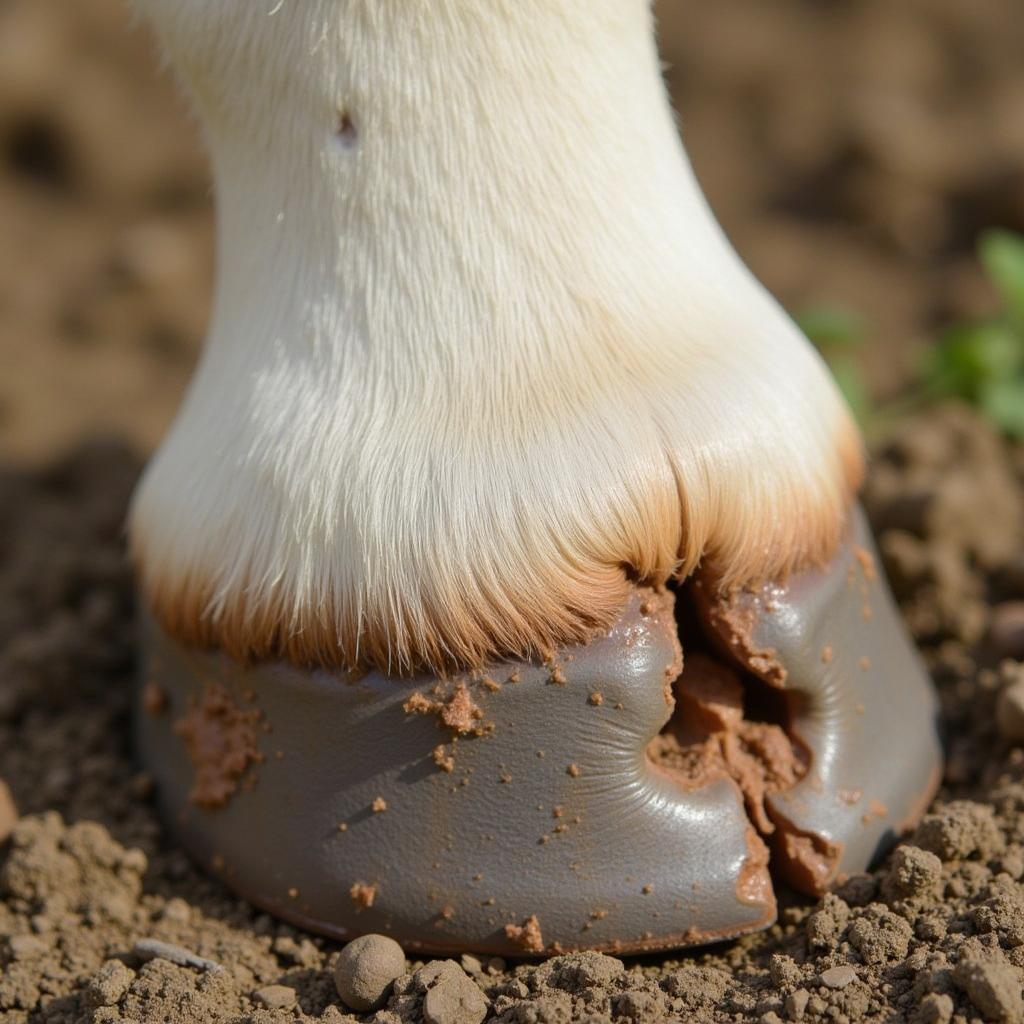Horse Heel Bulb Peeling can be a frustrating and concerning issue for horse owners. This article will delve into the various reasons why your horse’s heel bulbs might be peeling, offering practical solutions for treatment and prevention.
Understanding the Horse’s Heel Bulb
The heel bulb is the rounded, fleshy area at the back of the horse’s hoof, just above the coronary band. It plays a vital role in protecting sensitive structures within the hoof and acts as a shock absorber. Healthy heel bulbs are smooth, firm, and free from cracks, scabs, or peeling.
Common Causes of Horse Heel Bulb Peeling
Several factors can contribute to horse heel bulb peeling, ranging from environmental conditions to underlying health issues.
Environmental Factors
- Muddy or Wet Conditions: Prolonged exposure to mud and moisture can soften the heel bulbs, making them more susceptible to damage and peeling. This is especially true during periods of heavy rain or if horses are kept in poorly drained pastures.
- Dry Conditions: Ironically, excessively dry conditions can also lead to heel bulb peeling. Dry, cracked skin is more prone to flaking and peeling.
- Irritants: Exposure to certain irritants, such as harsh chemicals in cleaning products or certain types of bedding, can cause inflammation and peeling of the heel bulbs.
Health Issues
- Mites: Microscopic mites can infest the heel bulbs, causing intense itching and irritation that leads to scratching and subsequent peeling.
- Fungal Infections: Fungal infections, such as dermatophytosis (ringworm), can affect the heel bulbs, resulting in scaling, crusting, and peeling.
- Bacterial Infections: Bacterial infections can also cause inflammation and peeling of the heel bulbs, often accompanied by discharge and a foul odor.
- Allergies: Horses can develop allergies to various substances, including certain plants, insects, or even components of their feed. Allergic reactions can manifest as skin irritation and peeling, including on the heel bulbs.
 Horse Heel Bulb Anatomy: A Detailed View
Horse Heel Bulb Anatomy: A Detailed View
Treating Horse Heel Bulb Peeling
The appropriate treatment for horse heel bulb peeling depends on the underlying cause. Accurate diagnosis is crucial for effective treatment.
Addressing Environmental Factors
- Improve Pasture Management: Ensure proper drainage in pastures to prevent excessively muddy conditions. Provide dry areas for horses to stand.
- Regular Hoof Cleaning: Regularly clean and dry the horse’s hooves, paying particular attention to the heel bulbs.
- Protective Ointments: Apply protective ointments or barrier creams to the heel bulbs to prevent further irritation and promote healing.
Treating Health Issues
- Veterinary Consultation: If you suspect mites, fungal, or bacterial infections, consult a veterinarian for proper diagnosis and treatment. They may prescribe specific medications, such as anti-parasitic, anti-fungal, or antibiotic ointments.
- Allergy Management: Identifying and eliminating the allergen is key to managing allergies. Your veterinarian can perform allergy testing to pinpoint the cause and recommend appropriate management strategies.
Preventing Horse Heel Bulb Peeling
Prevention is always better than cure. Taking proactive measures can significantly reduce the risk of horse heel bulb peeling.
- Maintain a Clean and Dry Environment: Ensure the horse’s stall and pasture are clean, dry, and well-ventilated.
- Regular Hoof Care: Regular hoof trimming and balancing are essential for overall hoof health, including the heel bulbs.
- Balanced Diet: A balanced diet that meets the horse’s nutritional needs supports healthy skin and hoof growth.
- Routine Inspections: Regularly inspect your horse’s hooves for any signs of abnormalities, such as peeling, cracks, or discharge.
What to Do if You Notice Peeling
If you notice your horse’s heel bulbs are peeling, don’t ignore it. Early intervention is crucial for preventing further complications. Contact your veterinarian for a proper diagnosis and treatment plan.
 Healthy Horse Heel Bulb: A Visual Guide
Healthy Horse Heel Bulb: A Visual Guide
Conclusion
Horse heel bulb peeling can be a sign of various underlying issues. By understanding the causes, implementing appropriate treatments, and taking preventative measures, you can help keep your horse’s hooves healthy and sound. Regular hoof care and a clean, dry environment are essential for preventing this common problem.
FAQ
-
Is horse heel bulb peeling always a serious problem?
Not necessarily. Sometimes, it can be caused by minor environmental factors. However, persistent peeling warrants veterinary attention. -
Can I treat horse heel bulb peeling myself?
While you can address some environmental causes, it’s best to consult a veterinarian for any persistent or concerning peeling. -
How can I prevent mud fever from causing heel bulb peeling?
Ensure proper pasture drainage and provide dry areas for your horse to stand. Regularly clean and dry the hooves. -
What are the signs of a mite infestation on the heel bulbs?
Intense itching, scratching, and the presence of small, crusty lesions are common signs of mite infestations. -
How long does it take for horse heel bulb peeling to heal?
The healing time varies depending on the cause and severity. Mild cases may resolve within a few weeks with proper care, while more severe cases may take longer. -
What can happen if horse heel bulb peeling is left untreated?
Untreated heel bulb peeling can lead to secondary infections, pain, lameness, and chronic hoof problems. -
Are certain breeds of horses more prone to heel bulb peeling?
While any breed can be affected, horses with feathered legs may be more susceptible due to the increased moisture retention around the heel bulbs.
Related Questions and Articles
- How to identify and treat thrush in horses
- The importance of regular hoof trimming
- Managing mud fever in horses
For further assistance, please contact us at Phone: 0772127271, Email: [email protected] or visit our address: QGM2+WX2, Vị Trung, Vị Thuỷ, Hậu Giang, Việt Nam. Our customer service team is available 24/7.